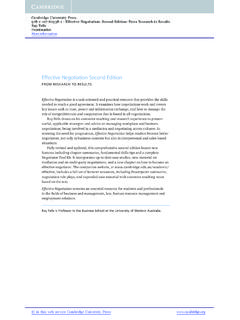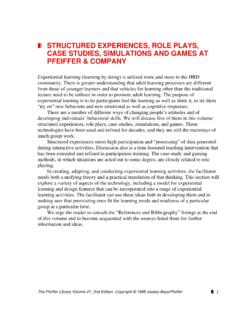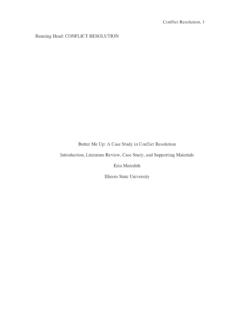Transcription of LANGUAGE AND NEGOTIATION: A MIDDLE EAST LEXICON L
1 Raymond CohenLanguage and DiplomacyLanguage and Negotiation: A MIDDLE east LexiconLANGUAGE AND NEGOTIATION: A MIDDLE east LEXICON1 Raymond CohenLooking back on the abortive Israeli-Syrian peace negotiations of1995-96, chief Israeli negotiator and distinguished Arabist ItamarRabinovich pondered the LANGUAGE gap between the two sides thatprevented their reaching agreement despite a clear convergence of inter-ests: The Israeli-Syrian dialogue , he remarked, was a striking exampleof the ability of the two old foes, who were trying to reach agreement, tospeak in the same terms but in a different LANGUAGE . 2 Why did Syriavigorously object to Israeli insistence on normalization , only eventu-ally to agree on normal peaceful relations ? What did Syrian spokes-men mean when they bitterly criticized Israel for bargaining aboutpeace? By definition, negotiation is an exercise in LANGUAGE and commu-nication, an attempt to create shared understanding where previously therehave been contested understandings.
2 When negotiation takes place acrosslanguages and cultures the scope for misunderstanding increases. So muchof negotiation involves arguments about words and concepts that it can-not be assumed that LANGUAGE is secondary and all that really counts isthe objective issues at stake. Can one ever speak of purely objectiveissues? When those issues include emotive, intangible concepts such as honor , standing , national identity , security , and justice can wereally take it for granted that the parties understand each other perfectly?And if not, what can be done to overcome LANGUAGE barriers?The MIDDLE east Negotiating LEXICON is an interpretive dictionary ofkey negotiating words in Arabic, Farsi, Hebrew, and Turkish. It is in-tended as a reference facility for English-speaking observers and practi-tioners of negotiation interested in clarifying LANGUAGE and resolving lin-guistic discrepancies. For those wondering just what Syrians understandby normalization and bargaining the LEXICON provides an analysis ofthe equivalent Arabic terms.
3 Alongside difficult, contested concepts suchas rights , disagreement , and peace , ordinary day-to-day negotiat-ing words like argument , instructions , and document are also in-terpreted. It emerges that ostensibly simple ideas may be as prone to cross-cultural variation as obviously complex notions. Nevertheless, it should67 LANGUAGE and DiplomacyRaymond CohenLanguage and Negotiation: A MIDDLE east Lexiconbe emphasized that the LEXICON is a guide to meaning rather than we negotiate is influenced by our understanding of what conces-sion , compromise and other key terms imply; yet there is no linearcause-and-effect relationship between conception and action. Our ac-tions depend on a range of other factors including circumstances, issues,personalities, power, and, crucially, the feedback received from our oppo-nent. What the LEXICON does is to suggest what MIDDLE Easterners meanwhen they refer to notions such as principle , commitment , and in-terest.
4 It does not purport to be a simplistic do-it-yourself manual ofnegotiating or a crystal ball, but a guide through a linguistic the usual dictionary-type definition, each entry seeks to givethe range of possible meanings of words, drawing attention to specialfeatures of use, describing possible religious and historical connotations,and analyzing the social and cultural associations evoked by the word forthe native speaker. Examples of use are taken from the daily press andaccounts of negotiators. In effect, each entry consists of a brief interpre-tive and illustrated discussion. Entries for each LANGUAGE were preparedby two mother-tongue researchers working separately to permit cross-checking and to control for blatantly subjective interpretations. Draft ver-sions were verified by a third senior academic who was also a native guidance and supervision was exercised by the author, who alsoedited the final the preparation of the LEXICON lay the conviction that differ-ences between languages matter deeply.
5 Living and working in two lan-guages, English and Hebrew, I was struck by how each LANGUAGE seemedto manifest a different outlook on the world. Things that could be saideasily and elegantly in one tongue lent themselves to laborious expres-sion in the other. Where one called for understatement, the other requiredhyperbole. Ostensibly slight nuances of tone and nice distinctions evokedquite far-reaching differences of association and meaning. Similar obser-vations have been made by many authors, nomads across cultures Indeed, the impossibility of translation lies at the heart ofcultural and linguistic distinctiveness (which does not mean that oneshould not try to bridge the gap). Personally, I had always been particu-larly impressed by the dramatically different sensibilities, ways of think-ing, feeling, and perceiving, reflected in the English Bible and the He-brew Bible or Tanach, for instance, in the Book of CohenLanguage and DiplomacyLanguage and Negotiation: A MIDDLE east LexiconOne day a friend interested in the Jewish roots of Christianity askedme if the Christological term the lamb of God (agnus dei) might not bean allusion to the Passover sacrifice in the Temple of Jerusalem.
6 Assum-ing that the first Christians would be fully conversant with the HebrewBible, I embarked on a small investigation. In Biblical Hebrew the pre-cise term for a sheep is of great importance: The society was a pastoralone and religious tradition was meticulous about the species, age, andgender of Temple sacrifices. If lamb or agnus refers to a young sheep (He-brew: seh) then the reference could not be to the Temple sacrifice dis-cussed in Leviticus (4:32, 35; 5:6, 7). Although translated as lamb , theoriginal Hebrew is keves, not seh. The more likely reference of agnus dei isto two other Hebrew Biblical references: One is the Exodus sacrifice of ayearling lamb (seh), whose blood was smeared on the lintels of the homesof the departing Israelites (Exodus 12:3-5). The other is the Akedah,Abraham s journey to Mount Moriah to sacrifice Isaac, his only son. Isaacasks: behold the fire and the wood, but where is the sacrificial lamb (seh)?
7 Abraham answers: God will provide the sacrificial seh (Genesis 22:7-8).As a political scientist and student of negotiation I concluded that if slightnuances of interpretation can be of such theological significance, thenperhaps differences in conceptualizing negotiation and conflict resolu-tion might also have important ANTINOMIESThe case for the importance of LANGUAGE and culture rests on the viewthat semantic distinctions reflect different interpretations of reality andnormative modes of behavior. Words and their translations are not justinterchangeable labels denoting some given, immutable feature of theworld but keys opening the door onto different configurations of the stone is an object that speakers of all languages can recognize and re-spond to at a non-linguistic level. They can kick it, throw it in a pond, oruse it to crack a nut. The moment LANGUAGE is used and the object isnamed, culture enters the picture.
8 As opposed to the thing itself, the word stone or its equivalents is a cultural notion. As such it is steeped in theculturally-grounded meanings of the given LANGUAGE community in thelight of its history, religion, customs, and environment. The word is69 LANGUAGE and DiplomacyRaymond CohenLanguage and Negotiation: A MIDDLE east Lexicontherefore a shorthand symbol capable of evoking a unique range of spe-cialized references, uses, and associations. Words are polysemic, that is,they have multiple clusters of meaning and usage. Across languages thesespreads of meaning occupy different semantic fields, though they may wellcoincide and overlap in certain places. Speakers of Hebrew and Englishmay talk of peace , using the word in appropriate contexts, and refer-ring to the same legal precedents. But what they mean by peace are subtlydifferent phenomena. Peace refers in English to a relationship estab-lished by treaty between states concluding war, an ideal prophetic visionof harmony, and tranquility.
9 Shalom shares in the Biblical vision of uni-versal accord but lacks the legal features that peace acquired in theEuropean state system from centuries of diplomatic practice. Moreover,deriving from an ancient Semitic root referring to wholeness or complete-ness, shalom importantly connotes health, welfare, greetings, and safety .Hence the common Israeli army bulletin broadcast after a military op-eration: All our planes returned b shalom to base. Here b shalom means safe and sound , not in peace .Drawing on the MIDDLE east Negotiating LEXICON it is possible to dis-tinguish between various categories of linguistic dissonance. The follow-ing very selective register of themes is not meant to be definitive but toclarify and exemplify the basic message of this entire exercise: that lan-guages are programmes for interpreting reality and mapping the bounda-ries of possible behavior, and that they do this in diverse ways.
10 If we havea guide to the difficult terrain, we will be better equipped to avoid are some basic antinomies:1. Different Distinctions DrawnEnglish, for reasons doubtless connected with the Anglo-Saxon regardfor democracy and the rule of law, and suspicion of untrammeled author-ity, is not very interested in drawing fine distinctions about the nature ofleadership. Significantly, apart from the pejorative term dictator , andloan words also referring to anti-democratic tendencies, such as f hrerand duce, leader covers all. Indeed, even leader can carry ironic con-notations of a bossy boots. Where distinctions are made it is by the use ofspecialist role words such as president, prime minister, secretary of state,70 Raymond CohenLanguage and DiplomacyLanguage and Negotiation: A MIDDLE east Lexicongovernor, chairman of the board, and so on. These role words are largelydevoid of extra-functional associations. In fact, the word president isused in the United States to mean the head of any business corporation,however minor, and sometimes self-appointed.










